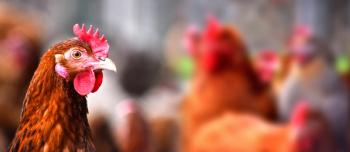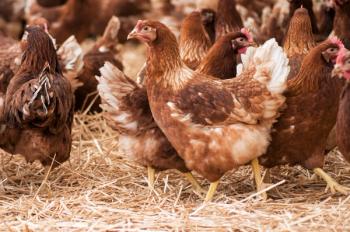
New approaches to treating and controlling milk fever (Proceedings)
Dairy cows approaching parturition with impending colostrogenesis have a tremendous increase in demand for energy, protein, and minerals along with changes in homeostatic mechanisms.
Dairy cows approaching parturition with impending colostrogenesis have a tremendous increase in demand for energy, protein, and minerals along with changes in homeostatic mechanisms. The fetal-placental mass requires 0.82 Mcal of energy, 117 g of protein, 10.3 g of calcium, 5.4 g of phosphorus, and 0.2 g of magnesium per day. In contrast, the production of 10 kg of colostrum requires 11 Mcal of energy, 140 g of protein, 23 g of calcium, 9 g of phosphorus, and 1 g magnesium. These nutrients are supplied to the uterus and mammary gland from dietary intake or body stores (Goff and Horst, 1997).
The calcium pool in a 600 kg cow is approximately 3.6 g of calcium in the plasma. The plasma pool is approximately 50% ionized and 50% protein bound. Interstitial fluid represents approximately 15% of the cow's body weight (90 L). The calcium concentration of this pool is 5 mg/dL of fluid so this pool contains approximately 4.5 g of which none is protein bound. These two pools combined represent the extracellular pool which totals approximately 8.1 grams of calcium. The intracellular pool of calcium only amounts to 0.01 g (Goff, 1999).
Clinical and sub-clinical hypocalcemia occurs commonly at parturition. Goff et al (1996) demonstrated that cows can remain sub-clinically hypocalcemic throughout the first week of lactation. Clinical and sub-clinical hypocalcemia results in decreased dry matter intake which will predispose the cow to the development of additional metabolic disease, reduced reproductive performance, depression of immune function, and increased rate of culling compared to cows that do not experience hypocalcemia.
Calcium homeostasis
Normal plasma calcium concentration is 8.5 – 10 mg/dL. Sub-clinical or mild hypocalcemia develops as the cow drops below 7.5 mg/dL. As plasma calcium drops into the range of 2-5 mg/dL the animal will be recumbent demonstrating typical signs of milk fever. If the plasma calcium drops below 2 mg/dL, death will typically occur.
The homeostatic mechanisms responsible for restoring calcium to normal levels are controlled by parathyroid hormone (PTH). PTH release in response to hypocalcemia acts directly on bone to increase the osteoclastic resorption of calcium, increase intestinal absorption of calcium via the activity of 1,25 dihydroxyvitamin D, and to enhance renal tubular resorption of calcium. Much research has been completed as to why cows that have normal levels of PTH in the periparturient period in response to clinical or sub-clinical hypocalcemia do not respond with increased levels of calcium to prevent or mitigate the effects of a large calcium draw associated with parturition.
This research led to the discovery that cows with metabolic alkalosis have an altered interaction between PTH and its receptors at the tissue level. This results in less skeletal resorption and intestinal absorption, thus predisposing the cow to sub-clinical and clinical hypocalcemia.
Early strategies to reduce the incidence of milk fever were to lower dietary calcium to extremely low levels (<60-80 gr/day). This should have resulted in high levels of PTH circulating in the blood and hopefully, overcome the altered receptor-PTH interaction. However, these diets were fairly impractical to implement and often contained forages that were locally grown on land fertilized with high levels of manure. This leads to increased uptake of potassium by the plants resulting in excessive levels of potassium in forage. The cationic effects high levels of potassium and sodium in the diet drives the cation-anion balance in the positive direction and results in development of metabolic alkalosis.
Treatment
Cows that are recumbent require immediate treatment to correct the hypocalcemia which will hopefully allow the cow to stand without assistance. Prolonged recumbency will result in severe myopathy and neuropathy as a result of “compartment-like” syndrome from tissue ischemia in the down limb to the weight of the animal's body.
To treat a recumbent 600 kg cow with milk fever, she will need to have approximately one half of her plasma calcium level replaced. Assuming that this cow has roughly 8.1 g of calcium in her extracellular pool, she would need somewhere around 4 g to replenish her deficit plus an additional pool to account for continuing loss to milk production. Most commercially available calcium solutions contain 8.5-11.5 g of calcium as a gluconate or borogluconate salt in a 500 mL solution.
Research has shown that this amount of calcium will be sufficient to restore the calcium deficit and provide a buffer for continuing loss. Based on this research, an effective dose of IV calcium is just less than 2 g calcium/100 kg of body weight. Intravenous calcium should be administered at a rate of approximately 1 g/minute. This rate may be too fast for cows that are especially sensitive to the cardiotoxic effects of calcium containing solutions, such as toxic cows. In situations where cows like this are treated with calcium containing solutions, care should be taken by using small bore needles (i.e. 16 g) and possibly using venous sites that take longer to deliver the calcium to the heart.
Calcium solutions may contain other electrolytes such as phosphorus, magnesium, potassium and often glucose. The phosphorus source is a phosphite which is biologically unavailable to the cow. Only phosphate containing solutions are available to the cow. Inclusion of phosphorus sources in the phosphate form in calcium and/or magnesium containing fluids will cause a precipitate to will develop. Precipitation between calcium or magnesium and phosphate can also occur in the blood. Therefore, IV administration of fluids that contain phosphates should not be given for at least two hours after IV administration of calcium or magnesium containing fluids.
Calcium containing fluids that contain magnesium are the only commercially available IV fluid with sufficient magnesium to treat cows with grass tetany. The combination of the two electrolytes does have clinical benefit as most cows that are hypomagnesemic are also hypocalcemic. The calcium provides a protective effect during IV treatment for magnesium deficiency. Magnesium solutions can be lethal as heart failure may develop due to altered Mg:Ca ratios in the cardiac muscle.
The inclusion of potassium (1-2 g/500 ml) is reportedly incorporated into calcium containing fluids as many cows with milk fever are hypokalemic. The second reason for inclusion is to provide a protective effect to the heart muscle from the cardiotoxic effects of IV calcium administration on the electric potential of the heart. These effects may not be clinically significant as: 1) calcium administration alone will increase potassium level in the plasma after restoration of intestinal motility and 2) it would seem unlikely that the administration of additional potassium, which represents 5-10% of the extracellular pool, would be sufficient to provide additional protective effects to the cardiac muscle.
Solutions containing dextrose or glucose, such as 50% dextrose and cal-dex solutions are being incriminated by some veterinarians as a risk factor in the development of hyperglycemia and potentially a left displaced abomasum. Clinical evaluation of blood glucose levels collected prior to the administration of calcium-dextrose solutions indicates that these cows are hyperglycemic. However, hypocalcemia prevents insulin secretion from the pancreas which results in hyperglycemia. Administration of calcium allows insulin to be released and may result in hypoglycemia.
Administration of the recommended concentration of IV calcium will result in an immediate increase in plasma calcium concentration (>20 mg/dL) and the effect will maintain plasma concentrations above pre-treatment levels for approximately four hours. Many practitioners will treat often treat a cow with 1.5-2 bottles of calcium in a single treatment which will drive plasma calcium concentration even higher. Fatal arrhythmia of the heart can begin to occur when plasma calcium concentration reaches 28-32 mg/dL. Administration of IV calcium will immediately reduce the PTH and cause the release of calcitonin. These effects will have a negative impact on the cow's ability to establish calcium homeostasis. Repeated IV calcium therapy may prevent a cow from ever establishing calcium homeostasis.
Alternate routes of administration are often utilized as adjuncts or replacements to IV therapy. Subcutaneous therapy of calcium can be completed using calcium solutions that do not contain dextrose. Administration of subcutaneous calcium should be limited to a volume of 50-75 mLs per site to prevent local tissue necrosis. Subcutaneous therapy can be an effective route but, it will not provide sufficient elevation in plasma calcium due to limited peripheral circulation during severe hypocalcemia.
Oral calcium administration will result in increased plasma calcium concentrations if the local calcium concentration at the mucosal surface is sufficient to initiate passive diffusion across the tight junctions of adjacent mucosal cells. The concentration needed to achieve this is approximately 6 mmol/L. Commercially available oral calcium products most often contain calcium chloride or calcium propionate. However, dilution of oral calcium products in large volumes of liquid may limit the clinical effectiveness of these products as they may not achieve sufficient concentration at the mucosal lining.
Calcium chloride products are more readily absorbed than other products and therefore, the dosing size can be smaller. Calcium propionate, while required in larger volume to be effective, also provides glucogenic precursors which may improve the clinical status of the cow. The main disadvantage to oral administration of calcium products is the potential for aspiration in hypocalcemic cows. Therefore, these products should only be administered to cows that are not exhibiting clinical signs or after improving plasma calcium status through the administration of IV calcium.
Recently, oral calcium boluses have been introduced into the US market that contains dual calcium source, calcium chloride and calcium sulfate. Advantages of these boluses over liquid products is that they reduce the risk of aspiration pneumonia and the dual calcium source provides an immediate source of available calcium via the calcium chloride and a prolonged source via the calcium sulfate.
Many practitioners will administer calcium via the IV route and provide additional calcium via the subcutaneous or oral route to provide a buffer for additional demands. While this method seems logical, it may not be the best strategy as this may not sustain plasma level for longer periods of time; it may elevate plasma levels near lethal levels, and reduces the endocrine system's response achieving calcium homeostasis. A more appropriate route would be to provide additional therapy six to twelve hours after the original treatment.
Prevention of hypocalcemia
As was mentioned earlier, the inclusion of forages in dry cow diets has complicated milk fever prevention due to high levels of potassium in many available forages. High levels of potassium in these diets drive blood pH towards metabolic alkalosis and reduce the functionality of PTH. There have been two approaches to mitigate the problem associated with high potassium forages.
The first and most recently developed has been the development of diets such as straw based close-up diets that utilize forages that are low in potassium. This stimulates less alkalosis and results in an additional benefit of having less dry matter intake depression in the days immediately prior to parturition. This effect places that animal in a more positive energy balance and reduces clinical and sub-clinical ketosis. It should be noted that not all straw is low in potassium and must be completely analyzed for mineral content.
The second method of milk fever prevention is through the manipulation of cation and anion levels in the diet in order to achieve a ration that has an excess of effective anions. This will in turn will drive the animal into a mild metabolic acidosis. The degree of metabolic acidosis can be monitored through the measurement of urine pH. If the diet is formulated correctly, cattle fed rations that contain anionic products will have a drop in pH within 3-5 days after initiation of the diet. The goal is to formulate a diet that results in a urine pH between 6.2-6.8 for Holstein cows while Jersey cows may need to be slightly more acidic in order to achieve the desired effect.
Dietary acidification is achieved through the addition of individual salts such as ammonium chloride, magnesium sulfate, ammonium sulfate and calcium sulfate. The disadvantage of the use of individual salts is that they are relatively unpalatable to cattle and may result in decreased dry matter intake during the close-up feeding period. This in turn may lead to the development of fat mobilization during the pre-partum period and result in the development of hepatic lipidosis and Type II ketosis. Therefore, it is imperative to monitor urine pH for proper urine acidification and also dry matter intake of the animals consuming the diet to assure the dry matter intake depression is not occurring.
An alternate source of anions can be found in soybean products that have been treated with HCl. These products provide an effective method of providing anions and are not unpalatable like other anionic products. In many situations, these products actually improve dry matter intake. Monitoring the effectiveness of these products is the same as with other anionic products.
One caution that may complicate monitoring urine pH concerns cows that have been fed these products for three or more weeks. Apparently, these cows can use their bone stores to counteract the acidosis resulting in an increase of 0.5-0.8 pH units over cows that have been fed these anionic products for less than three weeks. If close-up cows are fed these products for longer than three weeks, monitoring of urine pH should only be completed on cows that have been fed the product for less than three weeks.
Summary
Sub-clinical and clinical hypocalcemia is a common problem in periparturient dairy cattle, often lasting throughout the first week of the lactation. Hypocalcemia decreases milk production, decreases disease resistance, reduces reproductive performance and leads to higher culling rates compared to cows that do not experience hypocalcemia. Calcium homeostasis is controlled very tightly through hormonal regulation via parathyroid hormone and calcitonin.
Hypocalcemia is effectively treated through the use of intravenous calcium products. There are several products with various ingredients that can be successfully used for the treatment. In addition, there are several products that can be used as adjunct therapies via subcutaneous or oral route.
Milk fever prevention centers on creating a metabolic environment during the close-up feeding period that allows PTH to effectively interact with its receptors. This can be accomplished through maintaining low potassium levels in the diet as high potassium levels result in metabolic alkalosis. This in turn interferes with PTH activity. If potassium levels cannot be diluted, the addition of products that supply anions to the diet to counteract the effects of the potassium and allow for more effective PTH activity. If done correctly, this can result in almost complete elimination of milk fever in periparturient cows.
Newsletter
From exam room tips to practice management insights, get trusted veterinary news delivered straight to your inbox—subscribe to dvm360.




